The state of the art.
Update October 14, 2024: The sound became intermittent in the LG OLED TV, necessitating replacement of the motherboard, a process I illustrate here.
Five years ago I updated my 42″ Vizio LCD TV to a 55″ model, and the saga appeared here.
At the conclusion of that piece, after two years’ use, I wrote:

Technology has moved on and since that $700 LCD TV of yore we have seen the introduction of LED panels – thinner and lighter – and the more recent development of OLED displays, one also found in the much hyped iPhone X. And 4K, meaning 2160 pixels to the inch compared with 1080 for regular HD, is now mainstream.
From Wikipedia:
“An organic light-emitting diode (OLED) is a light-emitting diode (LED) in which the emissive electroluminescent layer is a film of organic compound that emits light in response to an electric current. This layer of organic semiconductor is situated between two electrodes; typically, at least one of these electrodes is transparent. OLEDs are used to create digital displays in devices such as television screens, computer monitors, portable systems such as mobile phones, handheld game consoles and PDAs. A major area of research is the development of white OLED devices for use in solid-state lighting applications.”
The bottom line is a picture with pitch black blacks and a very high dynamic range; quite literally like nothing seen before in flat panel technology.
Now this gain does not come cheap. I decided to up the panel size to 65″ diagonal, having more room in my Scottsdale home than in the Bay Area apartment of yore. That’s a 40% increase in display area (the ratio of the squares of the diagonals) yet the increase in TV width is but four inches. Here’s why:
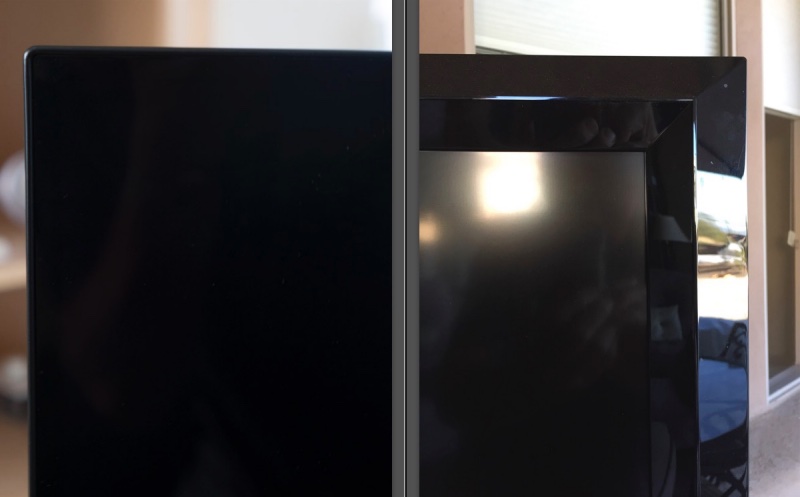
The LG bezel at left, Vizio at right.
LG has worked miracles with this display, for the bezel is almost non-existent, compared with the 1.5″ one on the Vizio. So that’s an immediate width reduction of almost 3″ in the LG, offsetting the larger screen dimensions.
But it gets better. I’m not sure that display thickness means anything, unless you are hanging the set on the wall, I suppose, but it’s fair to say that the thinness of the LG’s display defies belief:
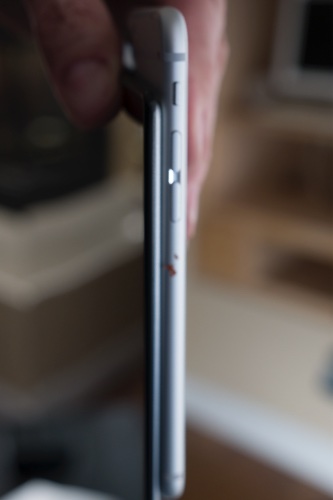
The thickness of the LG panel compared with an iPhone6.
The iPhone 6 is one of the slimmest smartphones on the market with a thickness of just 0.27″. Wait for it …. the LG comes in at 0.16″. Almost half the thickness. Stunning. So thin is the LG panel that extra care in handling has to be used when unpacking the set, to avoid damage. LG’s instructions specifically address the right way to do this. That said, the LG 65″ TV weighs in at a scant 54.5 lbs, something my son and I could easily manhandle into place. The full specs are here; a 55″ version is also available for smaller rooms.
The oft quoted rule that you should buy a TV right before Brain Damage Sunday (aka The Superbowl) may not apply here. It is very difficult to make fault-free large OLED panels – as far as I know the only manufacturers are LG, Samsung and Sony – and 4K displays have four times the pixel density of regular 1080p HD ones. I calculate the 65″ OLED display to have over 4.9 billion pixels. Just one bad pixel and the panel is a goner. I would hate to be in the 4K panel manufacturing business …. Here’s the price trend – after the usual big post-introduction drop the price has actually risen from my purchase date:
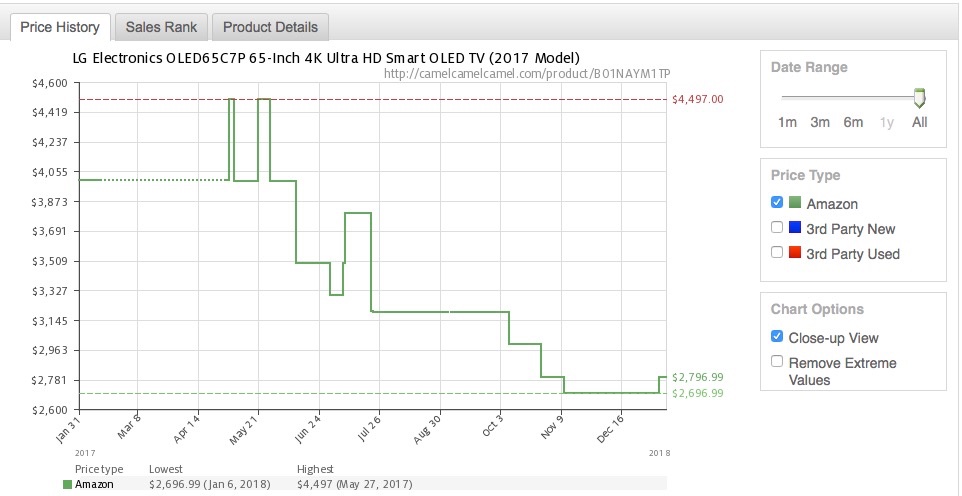
65″ 2017 LG price trend. Click the image.
The rear base of the panel is thicker to accommodate electronics and speakers, though with a display of this quality it really does not do to go with the internal speakers, which are simply too small to do the set justice.
The Market God having been good to me lately I splashed out on a pair of Martin Logan ESLs, an electrostatic design which makes for exceptional transparency while making a dramatic design statement. These suspend a thin transparent film (think Saran wrap) between two highly charged panels; alter the current delivered and the thin film membrane moves, just like a loudspeaker’s cone, but many times lighter, so more responsive. Indeed, the design means that the speakers are literally transparent, the charged plates either side of the membrane being heavily perforated. The trade off is that these present a very low impedance (2 ohms, compared with the 4-8 ohms of regular cone speakers) but very high capacitance load to the amplifier, so not just any amp will work in a stable manner at high current loads. Simply stated, if the amplifier manufacturer does not quote RMS power delivery into sub-4 ohm loads you should look elsewhere.
There is a lot of overpriced trash in the high end speaker sector. Martin Logan has been around for ever and appears financially stable.
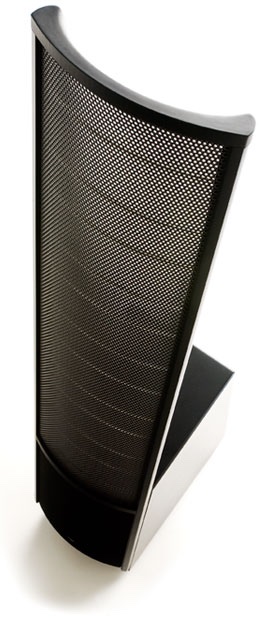
A very special loudspeaker – the Martin Logan ESL.
Other makers I would look at include the British Bowers & Wilkins and the no less British Quad Electroacoustics. You can bet most of the megabuck manufacturers out there will be so much Chapter XI dross a year or two hence after the next financial meltdown. Bread on the table tends to beat high-priced speakers in the corner. These three are survivors; indeed, Peter Walker of Quad fame brought the first full range electrostatic speaker to market in 1955. All three of the manufacturers I mention have been around for decades, and my 40 year old pair of B&W DM3 bookshelf speakers remains as good today as it did in 1977 when first purchased.
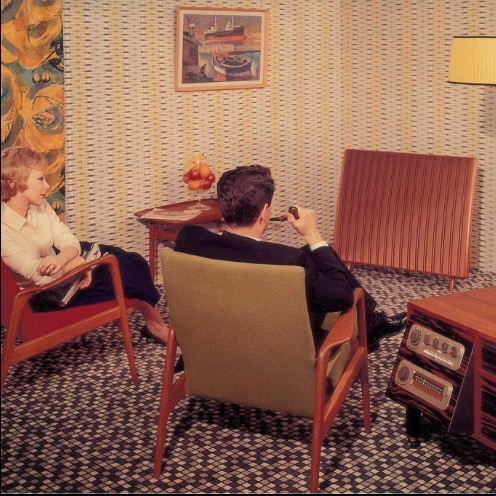
Flashback to 1955. Monaural sound, a pipe,
the Quad ESL, ghastly furniture and an
obedient spouse. Quad tube electronics at right.
Further, look for an amplifier which delivers high current to the speakers; as a rule of thumb, that means an amplifier which weighs a lot – 18 lbs or more. That may sound like a strange metric, but high current amplifiers need large transformers, and large transformers weigh more than small ones! With such fine speakers as the Martin Logan electrostatics it was time to upgrade the (excellent) Onkyo TX-8160 which delivers 80 watts RMS into 8 ohms and happily increases that to 140 watts into 2 ohms. Yes, it’s a high current device.
Another issue with electrostatic speakers – in addition to needing a constant power supply to energize the panels – is that they are not very good at delivering the bone-crunching bass power common in modern movies. Martin Logan partially addresses this by crossing over to a traditional cone woofer at 500Hz but the speaker still runs out of grunt in the 20-100Hz range. Down to about 100 Hz they are fine but that’s about all she wrote at the lower end. So to fill in the bottom octaves I have added a Martin Logan Dynamo 700 powered subwoofer which packs 700 watts of power and goes handily down to 20Hz or so. Again, not for rock freaks, for this is an intensely musical device which renders the deep notes just so, without exaggeration. Try the opening 32Hz organ note on the Solti/Chicago Symphony recording of Mahler’s Eight Symphony. That is how a pipe organ sounds.
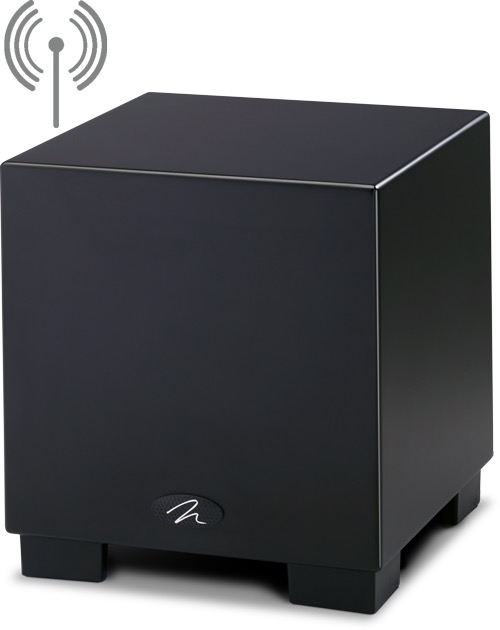
The Martin Logan Dynamo 700 subwoofer. Low notes are rendered correctly.
While ML offers a wireless module for the Dynamo 700 (and you can get 1000 and even 1500 watt versions) I used cables as wireless is just one more interference source in a world crowded with wireless waveforms. You can’t beat copper wires.
How about 4K content? The best repository of streaming 4K content is to be found in iTunes and you will need the AppleTV 4K streaming device to deliver it, as well as a high bandwidth broadband connection. Historically Apple’s movies have been overpriced but they have smartened up. Not only is all 4K content still priced at $6 a rental, any existing movies you may have already purchased will be upgraded to 4K free if that format is available. There are other streaming devices, like the Roku, but none compares for user interface and 4K movie choice to Apple’s offering. The only drawback is that Disney movies (meaning Disney, Pixar and the pap that is Star Wars) and YouTube content are not available in 4K on the AppleTV which I would regard as a feature not a drawback. Indeed Star Wars may well lay claim to having fomented more brain damage in America’s youth than American football.
One of the nicest features of the AppleTV 4K is the remote control which can be easily programmed to control your receiver’s volume as well as powering the AppleTV and your OLED TV on and off with the press of any button. The touchpad takes a bit of getting used to, but practice makes perfect. Best of all, the Siri voice activated feature works perfectly, unlike in any iOS device I have used.
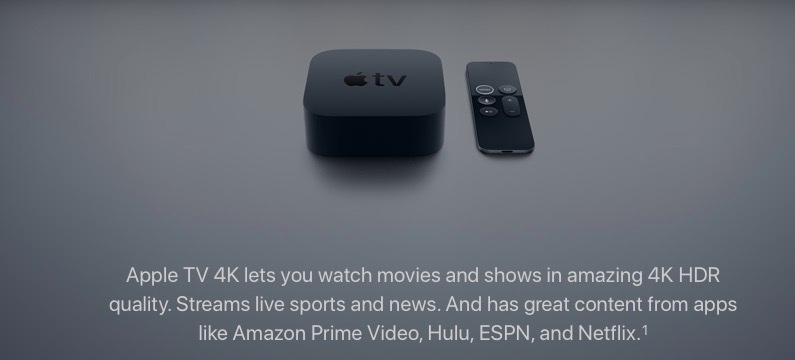
Click the image.
The icing on the cake is that Apple has just added Amazon Prime (free and paid) movies to the AppleTV interface (it even pops up in older 3rd generation 1080p AppleTVs), and while Amazon’s UI is indistinguishable from a bilge pump (both suck), free is good. One day the egos at Disney and Apple will effect a compromise and you will be able to watch all the Star Wars garbage on your spanking new OLED TV in revolting 4K detail. Yecch!
Setting up:
TV setup is potentially a daunting prospect, for the sheer number of user adjustable variables in the LG OLED TV is overwhelming. However, there are people out there who do this sort of thing for a living and one of the best guides I have found is here. The only setting I disagree with is ‘OLED light’ which they have at 16; 50 works better in my environment. Also, it bears repeating what these folks say – be sure to turn off ‘Energy Saver’ or you will think your new OLED TV is broken. The Saver delivers impossibly muddy results.
Setup of the speakers is far easier. Shine a flashlight at the panels from your listening position so that the reflection is one third of the way in from the inside vertical edge. Then fit the spikes to tilt the speakers back and you are done. Martin Logan has a truly exceptional set of instructions, written in clear, idiomatic English; these go into far more detail and include a fascinating history of the design of electrostatic speakers, with due credit given to the great Peter Walker and his original Quad ESL. The folks at ML are a class act. (‘QUAD’ stands for ‘Quality Unit Amplifier, Domestic’ and refers to the company’s pioneering tube amplifier and its first commercial product, a later variant of which I used for decades).
Setting up the subwoofer is trivial. Dial in a crossover point around 100Hz using the back panel controls and adjust the volume to suit.
Worth it? If you aspire to a Rolls Royce, then you do not ask the price of entry.
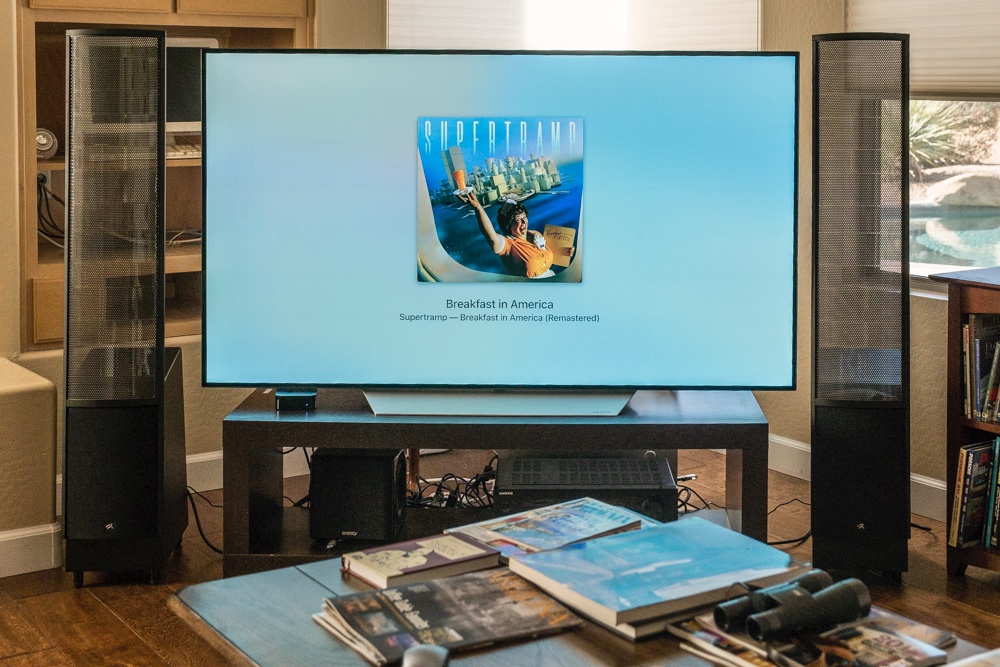
“Could we have kippers for breakfast?”
What of that old 55″ Vizio? Why, it’s doing sterling duty on the patio:
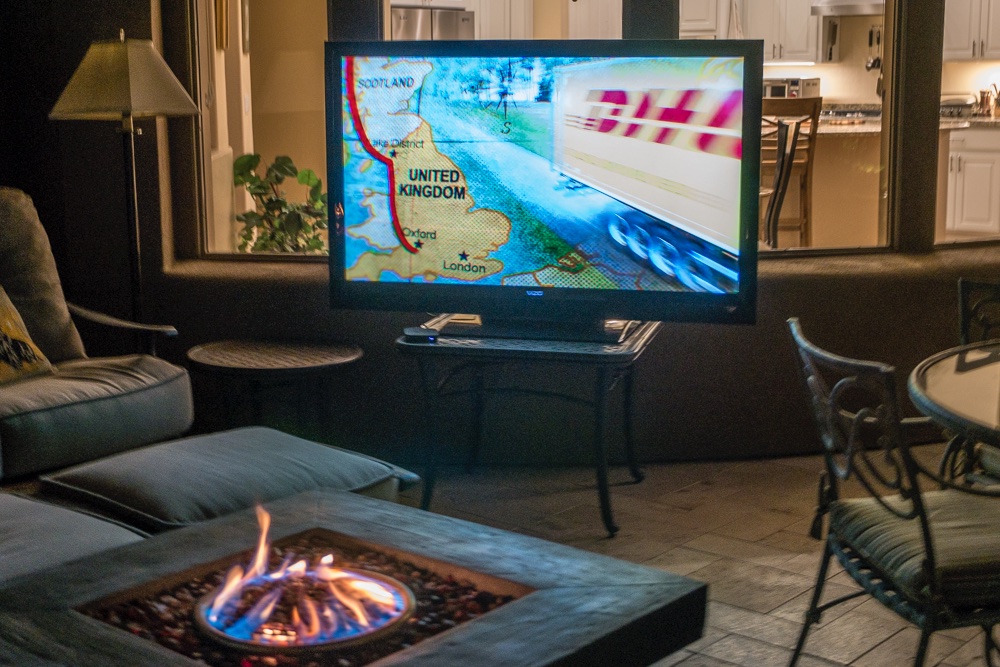
1080p Vizio TV with matching 1080p Gen3 AppleTV.